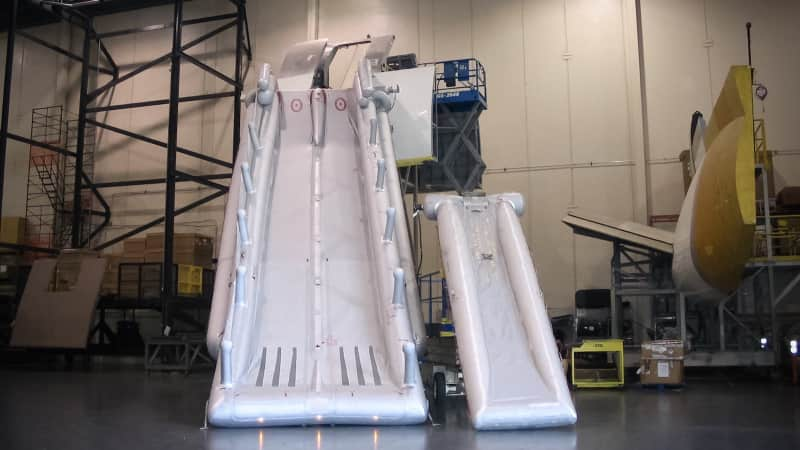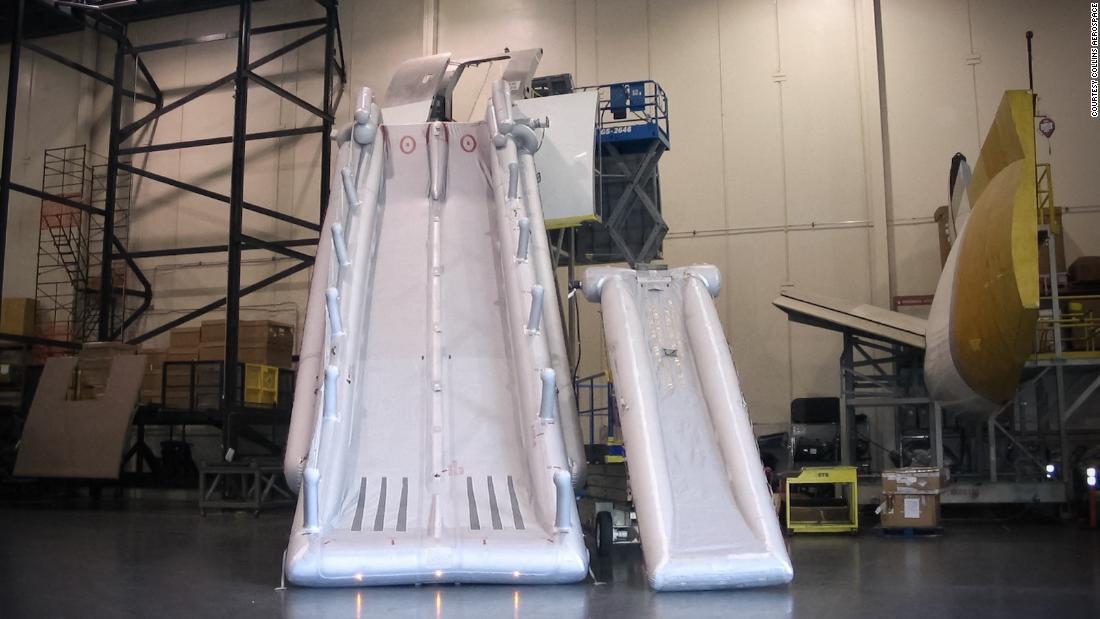(CNN) — “Arm doors and cross check.”
Almost all airline passengers have heard that instruction given by a flight attendant over the PA system, just before the plane leaves the terminal gate.
For most travelers, it’s part of the pre-flight ritual that often fades into the background, much like the safety briefing.
But that command is integral to the safety of the passengers and crew, preparing a critical device for immediate activation — the plane’s evacuation slides.
In the case of an emergency on the ground, inflatable slides deploy from the doors and the wing exits, giving passengers a quick way to escape from an aircraft. It’s a technology that has its roots at the dawn of the jet age in the 1950s but was preceded by a much simpler escape solution.
Early escapes
The very first passenger land planes all shared a common trait — a tail wheel. These early aircraft from Ford, Fokker and de Havilland, and then Douglas and Boeing, usually had a door near the tail of the plane, close to the ground.
Passengers climbed a few steps, and then headed uphill to their seats, with the cabin angled upwards towards the cockpit. If an evacuation was ordered by the captain, the passengers could exit using the main entry door.
As commercial planes got bigger, the tailwheel configuration became unwieldly for larger passenger and cargo loads. Nosewheel-equipped aircraft were introduced, leveling the cabin on the ground, but requiring a long flight of stairs to access the entry doors.
In an emergency, it was unlikely that passengers could safely jump from the cabin to the ground, so a crude solution was developed.
“Then they came up with flat pieces of fabric that were stretched between two arms, that had to be held to let people slide down. They called them chutes and we still call our slides chutes today.”
Those simple fabric chutes evolved into today’s sophisticated slides, which are Inflated by a compact, compressed gas cylinder.
But knotted ropes can still be found on plane flight decks, available for pilots if they need to evacuate through the cockpit windows or emergency hatch.
Six feet and higher
Collins Aerospace and its predecessor company, Goodrich, has designed and manufactured inflatable slides for decades, going back to the 1960s-era Boeing 747, the “Queen of the Skies.”
While materials and manufacturing techniques have naturally evolved since the first slides were introduced, the basic concept and design of today’s evacuation slides hasn’t changed much, according to Pope.
“Picture a ladder made of inflatable tubes, with fabric that spans between the tubes. Now those rungs in the middle, those inflatable tubes, may be intended to keep the side tubes apart and might not touch the fabric that spans them. And you have a head-end tube that interfaces with the aircraft and a toe-end tube that interfaces with the ground.”

On the left is an evacuation slide for an Airbus A380. The one on the right has been designed for a Boeing 737.
Courtesy Collins Aerospace
When a slide is designed, careful consideration must be given to the procedure used to fold it into its enclosure in the aircraft — a process that’s akin to packing a parachute.
“When we do a new slide development program, we have a very skilled team of technicians that have packed most of their career. We lean on them to develop the packing schemes and we write detailed sets of instructions,” says Pope.
The US Federal Aviation Administration has developed a set of requirements for slides, which have changed over time as emergency deployments have occurred, giving the regulators real-life incidents as a reference.
The specifications cover all aspects of the design including the strength, flammability and heat resistance of the fabrics, emergency lighting and the maximum inflation time — between six and 10 seconds — depending on the location of the slide.
They must deploy properly in all weather conditions, as cold as -40F and as hot as 160F, in rainfall up to one inch an hour, and with 25 knot winds hitting the slide from 45 degree angles around the plane.
Passenger aircraft with a door sill over six feet above the ground must be equipped with a slide, and long-range jets generally carry slides with integrated life-rafts.
Unique designs
An aircraft’s shape directly impacts the design of its slides, with each “chute” generally unique for its location.
“We’re sometimes able to put the same slide on multiple doors, but that’s not the norm. Usually the aircraft has a contour, and we have to design our inflatables to meet the contour requirements and attach to the aircraft properly in all the extreme conditions we have to meet,” says Pope.
The double-decker Airbus A380 proved to be a challenge for Collins. The mega-jet has a total of 16 slides — eight on the upper deck, and eight on the lower deck.
The designers had to make sure that the slide configuration meshed, so that the upper and lower deck slides didn’t interfere with each other. Space constraints for slide storage also needed special attention.
“It went through an incredible amount of tests. We would test a door position on an A380 a thousand times. A thousand deployments to develop it and then qualify it before it gets put on an airplane,” explains Ritz Rautenbach, who works in business development for Collins’ evacuation systems.
“Simple is better, but on the A380 we just didn’t have the space to fit a conventional system and make it practical. We had to come up with a unique design for the inflation system.”

An aircraft’s shape directly impacts the design of its slides.
Courtesy Collins Aerospace
Collins, working with aircraft manufacturers, must demonstrate that all the passengers and crew can evacuate an aircraft in 90 seconds or less.
“We have an evacuation rate test, where we demonstrate the slide can handle evacuees in various conditions, like with a high door sill, low door sill, or in night conditions. We test trained evacuees, we test naïve evacuees, and we make sure they’ve got the proper footwear on and they’re properly dressed,” says Pope.
Like so many safety-related aviation technologies, evacuation slides are rarely seen by passengers, but can save lives when they’re needed. And that drives the team at Collins, adds Pope.
“I love what we do, building safety equipment. We don’t want to see it used and we hate the situation that it’s used in. But when we see it being used, and we show it to our people and they see what they do is really important, it gives us all a sense of pride.”
Top image: An employee practices an emergency evacuation using an aircraft slide at the opening of EasyJet Plc’s European training facility at London Gatwick Airport in 2015. Credit: Chris Ratcliffe/Bloomberg/Getty Images
